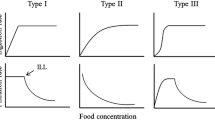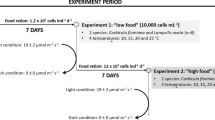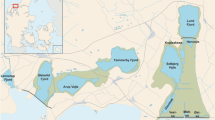Abstract
Suspension feeding by bivalves has been hypothesized to control phytoplankton biomass in shallow aquatic ecosystems. Lake Waccamaw, North Carolina, USA is a shallow lake with a diverse bivalve assemblage and low to moderate phytoplankton biomass levels. Filtration and ingestion rates of two relatively abundant species in the lake, the endemic unionid, Elliptio waccamawensis, and an introduced species, Corbicula fluminea, were measured in experiments using natural phytoplankton for durations of 1 to 6 days. Measured filtration and ingestion rates averaged 1.78 and 1.121 ind.−1 d−1, much too low to control phytoplankton at the observed phytoplankton biomass levels and growth rates. Measured ingestion rates averaged 4.80 and 1.50 µg chlorophyll a ind.−1 d−1, too low to support individuals of either species. The abundance of benthic microalgae in Lake Waccamaw reaches 200 mg chlorophyll a m−2 in the littoral zone and averages almost an order of magnitude higher than depth-integrated phytoplankton chlorophyll a. Total microalgal biomass in the lake is therefore not controlled by suspension feeding by bivalves.
Similar content being viewed by others
References
Andersen, F. Ø & K. R. Olsen, 1994. Nutrient cycling in shallow, oligotrophic Lake Kvie, Denmark. II: Effects of isoetids on the exchange of phosphorus between sediment and water. Hydrobiologia 275/276: 267–276.
Auerbach, S. I., D. E. Reichle & E. C. Struxness, 1977. Environmental Sciences Division Annual Progress Report ORNL 5257. Oak Ridge National Laboratory, Oak Ridge, TN, 295 pp.
Cahoon, L. B. & J. R. Kucklick, 1993. Characteristics of nitrogen fixation in Lake Waccamaw, North Carolina. J. Elisha Mitchell sci. Soc. 109: 20–29.
Cahoon, L. B., J. R. Kucklick & J. C. Stager, 1990. A natural phosphate source for Lake Waccamaw, North Carolina, USA. Int. Revue ges. Hydrobiol. 75: 339–351.
Cahoon, L. B., W. D. Grater & D. L. Covington, 1992. Phenotypic and genotypic differences between two adjacent populations of the Asiatic clam, Corbicula fluminea. J. Elisha Mitchell sci. Soc. 108: 57–63.
Casterlin, M. E., W. W. Reynolds, D. G. Lindquist & C. G. Yarbrough, 1984. Algal and physiochemical indicators of eutrophication in a lake harboring endemic species: Lake Waccamaw, North Carolina. J. Elisha Mitchell sci. Soc. 100: 83–103.
Cloern, J. E., 1982. Does the benthos control phytoplankton biomass in South San Francisco Bay? Mar. Ecol. (Prog. Ser.) 9: 191–202.
Cohen, R. R. H., P. V. Dresler, E. J. P. Philips & R. L. Cory, 1984. The effects of the Asiatic clam, Corbicula fluminea, on phytoplankton of the Potomac River, Maryland. Limnol. Oceanogr. 29: 170–180.
Creager, C. S., 1984. Modeling of phosphate concentrations in Lake Waccamaw, N.C., with an analysis of economic alternatives and policy options to preserve water quality. M.S. thesis, Duke University, 127 pp.
Dame, R. F. & N. Dankers, 1988. Uptake and release of materials by a Wadden Sea mussel bed. J. exp. mar. Biol. Ecol. 118: 207–216.
Diaz, R. J., 1974. Asiatic clam, Corbicula manilensis (Philippi), in the tidal James River, Virginia. Ches. Sci. 15: 118–120.
Doering, P. H. & C. A. Oviatt, 1986. Application of filtration rate models to field populations of bivalves: an assessment using experimental mesocosms. Mar. Ecol. (Prog. Ser.) 31: 265–275.
Eng, L., 1979. Population dynamics of the Asiatic clam, Corbicula fluminea (Muller), in the concrete-lined Delta-Mendota Canal of central California. In J. C. Britton (ed.), Proceedings, First International Corbicula Symposium, Texas Christian University, Fort Worth, Texas: 39–68.
Frost, B. W., 1972. The effects of size and concentration of food particles on the feeding behavior of the marine planktonic copepod Calanus pacificus. Limnol. Oceanogr. 17: 805–815.
Fuller, S. L. H. & C. E. Powell, Jr., 1973. Range extentions of Corbicula manilensis (Philippi) in the Atlantic Drainage of the United States. Nautilus 87: 59.
Guillard, R. R. L. & J. H. Ryther, 1962. Studies of marine planktonic diatoms. I. Cyclotella nana Hustedt and Detonula confervacea (Cleve) Gran. Can. J. Microbiol. 8: 229–239.
Habel, M. L., 1970. Oxygen consumption, temperature tolerance, and filtration rate of the introduced Asiatic clam Corbicula manilensis from the Tennessee River. M.S. thesis, Auburn University, 91 pp.
Hornbach, D. J., C. M. Way, T. E. Wissing & A. J. Burky, 1984. Effects of particle concentration and season on the filtration rates of the freshwater clam, Sphaerium striatinum Lamark (Bivalvia: Pisidiidae). Hydrobiologia 108: 83–96.
Kucklick, J. R., 1988. Undescribed sources of nutrients to Lake Waccamaw, North Carolina. M.S. thesis, UNC Wilmington, 116 pp.
Lauritsen, D. D., 1986a. Assimilation of radiolabeled algae by Corbicula. Am. malacol. Bull. Spec. ed. 2: 219–222.
Lauritsen, D. D., 1986b. Filter-feeding in Corbicula fluminea and its effect on seston removal. J. n. am. benthol. Soc. 5: 165–172.
Mattice, J. S., 1979. Interactions of Corbicula sp. with power plants. In J. C. Britton (ed.), Proceedings of the First International Corbicula Symposium, Texas Christian University, Oct. 13–15, 1977: 119–138.
McMahon, R. F., 1982. The occurrence and spread of the introduced Asiatic freshwater clam, Corbicula fluminea (Muller), in North America: 1924–1982. Nautilus 96: 134–141.
McMahon, R. F., 1991. Mollusca: Bivalvia. In J. H. Thorp & A. P. Covich (eds), Ecology and classification of North American freshwater invertebrates, Academi Press, NY: 315–399.
Møhlenberg, F. & H. W. Riisgard, 1979. Filtration rate, using a new indirect technique, in thirteen species of suspension feeding bivalves. Mar. Biol. 54: 143–147.
North Carolina Division of Environmental Management, 1983. North Carolina Clean Lakes Survey, 1982. North Carolina Department of Natural Resources and Community Development, Report #83–03. Raleigh, N.C., 394 pp.
North Carolina Division of Environmental Management, 1989. North Carolina Clean Lakes Survey, 1988. North Carolina Department of Natural Resources and Community Development, Report #89–04, Raleigh, N.C., 256 pp.
Officer, C. B., T. J. Smayda & R. Mann, 1982. Benthic filter feeding: A natural eutrophication control. Mar. Ecol. Prog. Ser. 9: 203–210.
Owen, D. A., 1990. Trophic study of a shallow lake: Lake Waccamaw, North Carolina. M.S. thesis, UNC Wilmington, 44 pp.
Parsons, T. R., Y. Maita & C. M. Lalli, 1984a. A manual of chemical and biological methods for seawater analysis. Pergamon Press, New York, 173 pp.
Parsons, T. R., M. Takahashi & B. T. Hargrave, 1984b. Biological Oceanographic Processes. Pergamon Press, New York, 330 pp.
Perrow, M. R., B. Moss & J. Stansfield, 1994. Trophic interactions in a shallow lake following a reduction in nutrient loading: a long-term study. Hydribiologia 275/276: 43–52.
Porter, H. J., 1985. Molluscan Census and Ecological Relationships, North Carolina Endangered Species Restoration Project, Final Report, Morehead City, N.C., 170 pp.
Prokopovich, N. P., 1969. Deposition of clastic sediments by clams. J. Seri. Petrol. 39: 891–901.
Stager, J. C. & L. B. Cahoon, 1992. The distribution of microalgae in littoral habitats in Lake Waccamaw, North Carolina. J. Elisha Mitchell sci. Soc. 108: 117–126.
Strickland, J. D. H. & T. R. Parsons, 1972. A practical handbook of seawater analysis. J. Fish. Res. Bd Can., Ottawa, Canada, 310 pp.
Weiss, C. M. & E. J. Keunzler, 1976. The trophic state of North Carolina lakes. Water Resources Research Institute of the University of North Carolina, Report #76, Raleigh, N.C., 224 pp.
Welschmeyer, N. A., 1994. Fluorometric analysis of chlorophyll a in the presence of chlorophyll b and phaeopigments. Limnol. Oceanogr. 39: 1985–1993.
Wetzel, R. G. & G. E. Likens, 1982. Limnological analyses. W. B. Saunders Co., Philadelphia, 357 pp.
Wium-Andersen, S., U. Anthoni, C. Christopherson & G. Houen, 1982. Allelopathic effects on phytoplankton by substances isolated from aquatic macrophytes (Charales). Oikos 39: 187–190.
Author information
Authors and Affiliations
Rights and permissions
About this article
Cite this article
Cahoon, L.B., Owen, D.A. Can suspension feeding by bivalves regulate phytoplankton biomass in Lake Waccamaw, North Carolina?. Hydrobiologia 325, 193–200 (1996). https://doi.org/10.1007/BF00014984
Received:
Revised:
Accepted:
Issue Date:
DOI: https://doi.org/10.1007/BF00014984




